#logistics automation market
Explore tagged Tumblr posts
Text
0 notes
Text
Embracing the Era of Automated Warehouse Robots
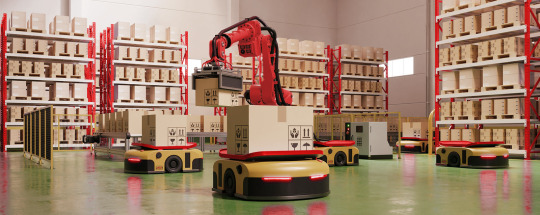
With a focus on warehouse automation and the implementation of cutting-edge mobile robotic solutions, Hitachi is revolutionizing the manufacturing landscape.
Central to this transformation is robotic palletizing, where advanced robots take charge of precise and efficient stacking of goods. This automation streamlines warehouse operations, optimizing productivity and minimizing errors.
Hitachi's expertise extends to logistics automation, incorporating robotic sorting and warehouse picking technologies. These robotic systems facilitate seamless order fulfillment, ensuring faster and error-free processes. By harnessing intelligent warehouse technology, Hitachi enhances overall inventory management, enabling accurate and efficient warehouse sorting. To further elevate efficiency, Hitachi has developed automated warehouse robots tailored for logistics tasks. These robots navigate warehouse spaces, facilitating smooth transportation and handling of goods.
Hitachi's dedication to excellence encompasses robotic inventory systems, harnessing the power of robotics and AI-driven technologies. These systems enable real-time tracking and monitoring of inventory levels, resulting in precise stock management and reduced discrepancies.
Hitachi's logistics and warehouse automation solutions encompass robotic depalletizing and palletizing solutions, warehouse picking, robotic warehouse sortation systems, automated guided vehicles and autonomous mobile robots.
Through these cutting-edge advancements, Hitachi is driving the future of warehousing, propelling it toward efficient, accurate, and technologically advanced operations.
Learn more on how scalable mobile robotic solutions manage the picking, sorting, and palletizing, making warehouse operations more efficient, cost-effective and safe:
Discover how Hitachi is enabling data-driven manufacturing automation to achieve sustainability and profitability:
#warehouse automation#warehouse robotics#logistics automation market#warehouse robots#warehouse technology#digital innovation#robotics#sustainability
0 notes
Text
Logistics Automation Market Size, Share & Trends Analysis 2030
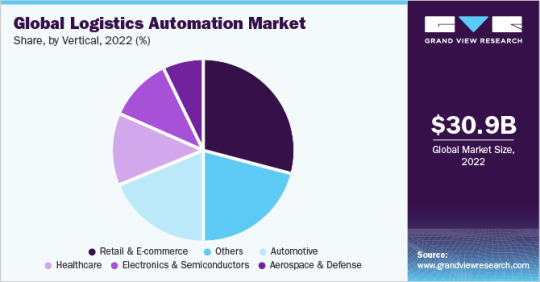
Logistics Automation Market Growth & Trends
The global logistics automation market size is expected to reach USD 90.00 billion by 2030, according to a new report by Grand View Research, Inc. The market is expected to witness a CAGR of 14.7% over the forecast period. Logistics operations are critical factors in the smooth functioning of the supply chain of any business, especially low-margin, high-volume businesses. The logistics sector is witnessing a continuous increase in investments with a significant emphasis on the automation of several logistics functions. Automation enhances efficiency and aids in integrating supply chains; thus, automation is increasingly getting adopted across sectors. The growing tendency of the logistics industry towards adopting automation solutions is one of the significant factors driving the growth of the logistics automation industry.
Request a free sample copy or view report summary: https://www.grandviewresearch.com/industry-analysis/logistics-automation-market-report
According to a DHL report published in 2018, 80% of warehouses do not have any automation support and are still operated manually, while 15% of the total warehouses are just mechanized, which means the warehouses use sorters, conveyors, picker solutions, and other machined equipment which are not necessarily automated. The report states that only 5% of total warehouses are automated. The trend displays a remarkable opportunity for the growth of the market in the coming years as companies are increasingly adopting automation in their warehouses, including autonomous robots, automated sorting systems, conveyor systems, etc. Technological development such as communication technologies, sensors, tracking devices, computer vision, artificial intelligence, and machine learning are aiding the growth of the target market.
The e-commerce boom is resulting in increasing adoption of automation solutions owing to the enormous volumes of shipments. The e-commerce shipment volume is growing exponentially by the year, and hence the warehouses require automation solutions to meet the short delivery timelines. The e-commerce fulfillment centers are implementing automated sorting and conveyor systems and highly benefit from inventory management and order management software. Moreover, the major labor challenges faced by the logistics industry across the globe are driving the demand for logistics automation solutions.
The COVID-19 pandemic accelerated the adoption of automation technologies such as robots, conveyors, and automation software, among others, in the logistics sector. The imposed lockdowns and social distancing norms necessitated the deployment of automation tools in warehouses and logistics functions. Although there were shortages and delays in receiving the hardware equipment during the lockdown, the market displayed a positive growth trend from 2020 to 2022.
Logistics Automation Market Report Highlights
The hardware segment dominated the market in 2022 with a market share of about 67%. Autonomous robots are the largest sub-segment of hardware components in terms of revenue owing to the increasing demand for automated warehouse logistics
The inventory & storage management function segment is anticipated to grow at a CAGR of 15.8% during the forecast period. The inventory & storage management ensures the stocks are maintained at optimum levels, and the demand for each product determines the stock levels
The sales logistics segment dominated the market in 2022, accounting for a market share of about 36%. Sales logistics is a critical aspect of the supply chain as it involves moving or delivering goods to the end consumer
The small and medium enterprises segment is anticipated to grow at the fastest CAGR of 15.6% during the forecast period. The growth can be attributed to the automation that helps SMEs to optimize their labor costs
The order management software segment held the largest market share in 2022. The dominance of the segment is owing to the need to fulfill the orders correctly and without any delivery delays. The order management process starts when an order is placed and ends when the customer receives the order
The retail and e-commerce segment is anticipated to grow at a CAGR of 15.2%. The growth can be attributed to the increasing preference for online shopping among consumers across the globe
The Asia Pacific segment is anticipated to register significant growth with a CAGR of 17.2%. The growth can be attributed to the increasing investments in logistics infrastructure projects in countries such as India and China
Logistics Automation Market Segmentation
Grand View Research has segmented the global logistics automation market based on component, function, logistics type, organization size, software application, vertical, and region.
Logistics Automation Component Outlook (Revenue, USD Billion, 2017 - 2030)
Hardware
Autonomous Robots (AGV, AMR)
Automated Storage and Retrieval Systems (AS/RS)
Automated Sorting Systems
De-palletizing/Palletizing Systems
Conveyor Systems
Automatic Identification and Data Collection (AIDC)
Software
Warehouse Management System
Transportation Management System
Services
Consulting
Deployment & Integration
Support & Maintenance
Logistics Automation Function Outlook (Revenue, USD Billion, 2017 - 2030)
Inventory & Storage Management
Transportation Management
Logistics Automation Logistics Type Outlook (Revenue, USD Billion, 2017 - 2030)
Sales Logistics
Production Logistics
Recovery Logistics
Procurement Logistics
Logistics Automation Organization Size Outlook (Revenue, USD Billion, 2017 - 2030)
Large Enterprises
Small & Medium Enterprises
Logistics Automation Software Application Outlook (Revenue, USD Billion, 2017 - 2030)
Inventory Management
Order Management
Yard Management
Shipping Management
Labor Management
Vendor Management
Customer Support
Others
Logistics Automation Vertical Outlook (Revenue, USD Billion, 2017 - 2030)
Retail & E-commerce
Healthcare
Automotive
Aerospace & Defense
Electronics & Semiconductors
Others
Regional Insights
North America led the overall market in 2022, with a market share of 33.74%. The region's growth can be attributed to the presence of several logistics automation solution providers and several logistics giants such as UPS, DHL, and FedEx Corporation, among others, in North America. In addition, the speedy implementation of modern technologies and the existence of modern infrastructure in the region is a supportive factor in the growth of the target market. The U.S. is expected to retain its dominance over the forecast period owing to the rapid boom of the e-commerce sector in the country.
The Asia-Pacific is expected to grow at the fastest CAGR of 17.2% over the forecast period. Asia Pacific is expected to experience rapid economic growth, especially in e-commerce. Moreover, Asia Pacific includes several countries which are hubs of logistical activity, such as Singapore, Indonesia, China, India, etc. Furthermore, the rising technological advancements and rising adoption of Industry 4.0 in countries such as China, India, Japan, and Southeast Asia countries are expected to boost the demand for logistics automation significantly over the forecast period.
List of Key Players in the Logistics Automation Market
Dematic Corp. (Kion Group AG)
Daifuku Co. Limited
Swisslog Holding AG (KUKA AG)
Honeywell International Inc.
Jungheinrich AG
Murata Machinery Ltd
Knapp AG
TGW Logistics Group GmbH
Kardex Group
Mecalux SA
Beumer Group GmbH & Co. KG
SSI Schaefer AG
Vanderlande Industries BV
WITRON Logistik
Oracle Corporation
One Network Enterprises Inc.
SAP SE
Authoritative Research: https://www.grandviewresearch.com/industry-analysis/logistics-automation-market-report
#Logistics Automation Market#Logistics Automation Market Size#Logistics Automation Market Share#Logistics Automation Market Trends
0 notes
Text
#SMS Marketing for Transportation And Logistics#SMS Marketing for Transportation#SMS Marketing Transportation And Logistics#sms marketing#bulk text messaging#mass text messaging#sms gateway#sms automation
0 notes
Text
AI, stands for artificial intelligence computer systems, that conduct tasks that historically required human intelligence to complete. This includes recognizing human speech, making decisions, identifying patterns, generating written content, steering a car or truck, and analyzing data. A lot of people today are wondering if the benefits of AI are worth the resulting human job losses, production efficiencies, cost savings, etc.? My new program, "Do We Really Want AI To Replace More Human Decision Making?"
#AI#artificial intelligence#Chat gpt#computer vision#computer systems#human intelligence#recognizing human speech#AI decision making#AI generated written content#driverless cars and trucks#AI data analysis#AI cost saving#AI production efficiencies#human job losses from AI#social media content recommendations#AI in medical diagnosis#AI identified trends and patterns#Google AI#Google search results#AI real time decisions#AI identified diseases#logistics management#AI marketing#AI could decide to take over#automated jobs#intrusive social surveillance#self aware AI
0 notes
Text
Elevating Communication with AI Voice Bot Technology
Imagine a world where businesses can have natural, intelligent conversations with their customers through technology. That’s exactly what an AI voice bot offers. Unlike traditional bots, these advanced systems understand context and respond with meaningful answers, making interactions smoother and more personal.
At VoiceOwl.ai, we’re dedicated to building AI voice bot solutions that fit seamlessly into your existing setup, helping automate customer service and make every interaction count.Our AI voice bots are designed to learn and improve over time, ensuring they keep up with your needs and provide the best possible responses.
Whether you need help with customer support, virtual assistants, or smart home devices, VoiceOwl.ai is here to bring the future of communication to your business.
#Lead verification automation#Lead Qualification automation#BFSI Automation#NBFC Automation#ABM Marketing Automation#Call Center Automation#Conversational AI#RCM Automation#E-commerce Automation#Logistics Automation#Recruitment Automation
0 notes
Text

𝐄𝐟𝐟𝐢𝐜𝐢𝐞𝐧𝐜𝐲 𝐔𝐧𝐥𝐞𝐚𝐬𝐡𝐞𝐝: 𝐈𝐧𝐧𝐨𝐯𝐚𝐭𝐢𝐨𝐧𝐬 𝐢𝐧 𝐭𝐡𝐞 𝐈𝐧𝐭𝐫𝐚𝐥𝐨𝐠𝐢𝐬𝐭𝐢𝐜𝐬 𝐌𝐚𝐫𝐤𝐞𝐭
𝐒𝐞𝐜𝐮𝐫𝐞 𝐚 𝐅𝐑𝐄𝐄 𝐒𝐚𝐦𝐩𝐥𝐞: https://www.nextmsc.com/intralogistics-market/request-sample
As the world of logistics continues to evolve, the intralogistics sector is at the forefront of innovation and efficiency. From advanced automation to AI-driven solutions, here's a snapshot of key trends shaping the industry:
𝐀𝐮𝐭𝐨𝐦𝐚𝐭𝐢𝐨𝐧 𝐑𝐞𝐯𝐨𝐥𝐮𝐭𝐢𝐨𝐧: Robotics and automated systems are transforming warehouses and distribution centers, enhancing speed and accuracy in handling goods.
𝐑𝐢𝐬𝐞 𝐨𝐟 𝐀𝐈 𝐚𝐧𝐝 𝐃𝐚𝐭𝐚 𝐀𝐧𝐚𝐥𝐲𝐭𝐢𝐜𝐬: AI-powered analytics are optimizing supply chain operations, predicting demand, and improving inventory management.
𝐆𝐥𝐨𝐛𝐚𝐥 𝐂𝐨𝐧𝐧𝐞𝐜𝐭𝐢𝐯𝐢𝐭𝐲: IoT and real-time tracking technologies are creating seamless supply chain networks, enabling businesses to operate on a global scale more efficiently.
𝐒𝐮𝐬𝐭𝐚𝐢𝐧𝐚𝐛𝐢𝐥𝐢𝐭𝐲 𝐈𝐧𝐢𝐭𝐢𝐚𝐭𝐢𝐯𝐞𝐬: Green logistics practices are gaining traction, with a focus on reducing carbon footprints through eco-friendly packaging and energy-efficient operations.
𝐒𝐞𝐜𝐮𝐫𝐢𝐭𝐲 𝐚𝐧𝐝 𝐒𝐚𝐟𝐞𝐭𝐲: Enhanced safety protocols and cybersecurity measures are prioritized to protect valuable data and ensure workplace safety.
𝐊𝐞𝐲 𝐏𝐥𝐚𝐲𝐞𝐫𝐬: The intralogistics industry includes various market players such as Daifuku Co. Ltd., Jungheinrich AG, Kion Group AG, Honeywell International Inc., Midea Group, Vanderlande, SSI Schaefer AG, KNAPP Group, Beumer Group GmbH and Co. KG, Autostore and others.
𝐀𝐜𝐜𝐞𝐬𝐬 𝐅𝐮𝐥𝐥 𝐑𝐞𝐩𝐨𝐫𝐭: https://www.nextmsc.com/report/intralogistics-market
Join us in exploring the future of intralogistics, where innovation meets efficiency, and businesses thrive in a connected world. Let's shape the future together!
#intralogistics#supply chain#automation#ai#logistics innovation#construction#market research#market trends#business insights#market analysis
0 notes
Text
Logistic Automation Market Size, Share, Types, Products, Trends, Growth, Applications and Forecast 2023 to 2030
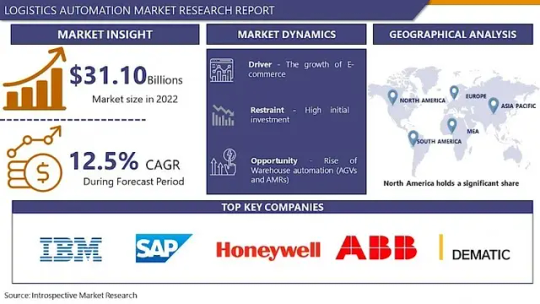
Logistic Automation Market Size Was Valued at USD 31.10 Billion in 2022, and is Projected to Reach USD 79.80 Billion by 2030, Growing at a CAGR of 12.5% From 2023-2030.
The rise of e-commerce has fueled the demand for efficient logistics operations. Retailers and logistics companies are increasingly adopting automation technologies to handle the surge in online orders and meet customer expectations for faster delivery times.
Warehouse automation solutions, including robotic systems, automated storage and retrieval systems (AS/RS), and autonomous vehicles, are being deployed to optimize warehouse operations. These technologies improve inventory management, order fulfillment accuracy, and overall efficiency.
Companies are leveraging automation to optimize their entire supply chain, from manufacturing facilities to distribution centers. Automation technologies such as predictive analytics, IoT sensors, and AI-powered logistics software are used to streamline processes, reduce costs, and enhance visibility across the supply chain.
Get Full PDF Sample Copy of Report: (Including Full TOC, List of Tables & Figures, Chart) @
https://introspectivemarketresearch.com/request/16763
Updated Version 2024 is available our Sample Report May Includes the:
Scope For 2024
Brief Introduction to the research report.
Table of Contents (Scope covered as a part of the study)
Top players in the market
Research framework (structure of the report)
Research methodology adopted by Worldwide Market Reports
Moreover, the report includes significant chapters such as Patent Analysis, Regulatory Framework, Technology Roadmap, BCG Matrix, Heat Map Analysis, Price Trend Analysis, and Investment Analysis which help to understand the market direction and movement in the current and upcoming years.
Leading players involved in the Logistic Automation Market include:
Dematic (US), Honeywell Intelligrated (US), Manhattan Associates (US), Mantis (US), Blue Yonder (US), Oracle (US), IBM(US), Zebra Technologies (US), O9 Solutions (US), JR Automation (US), Automated Logistics Systems (US), Symbotic (US), Daifuku (Japan), SBS Toshiba Logistics (Japan), Murata Machinery (Japan), and Other Major Players.
If You Have Any Query Logistic Automation Market Report, Visit:
https://introspectivemarketresearch.com/inquiry/16763
Segmentation of Logistic Automation Market:
By Component
Hardware
Software
Services
By Function
Inventory and Storage Management
Transportation Logistics
By Logistics Type
Sales Logistics
Production Logistics
Recovery Logistics
Procurement Logistics
By Organization Size
Large Enterprise
Small and Medium-Sized Enterprises (SMEs)
By Software
Inventory Management
Order Management
Yard Management
Shipping Management
Labour Management
Vendor Management
Customer Support
Transportation Management
Order Management
Warehouse Management
By Mode of Freight Transport
Air
Road
Sea
By Application
Transportation
Infotainment System
Safety and Alerting System
Others
By End-User
Manufacturing
Healthcare and Pharmaceuticals
Fast-Moving Consumer Goods
Retail and E-commerce
Automotive
Others
By Regions: -
North America (US, Canada, Mexico)
Eastern Europe (Bulgaria, The Czech Republic, Hungary, Poland, Romania, Rest of Eastern Europe)
Western Europe (Germany, UK, France, Netherlands, Italy, Russia, Spain, Rest of Western Europe)
Asia Pacific (China, India, Japan, South Korea, Malaysia, Thailand, Vietnam, The Philippines, Australia, New Zealand, Rest of APAC)
Middle East & Africa (Turkey, Bahrain, Kuwait, Saudi Arabia, Qatar, UAE, Israel, South Africa)
South America (Brazil, Argentina, Rest of SA)
Highlights from the report:
Market Study: It includes key market segments, key manufacturers covered, product range offered in the years considered, Global Logistic Automation Market, and research objectives. It also covers segmentation study provided in the report based on product type and application.
Market Executive Summary: This section highlights key studies, market growth rates, competitive landscape, market drivers, trends, and issues in addition to macro indicators.
Market Production by Region: The report provides data related to imports and exports, revenue, production and key players of all the studied regional markets are covered in this section.
Logistic Automation Market Profiles of Top Key Competitors: Analysis of each profiled Roll Hardness Tester market player is detailed in this section. This segment also provides SWOT analysis of individual players, products, production, value, capacity, and other important factors.
If you require any specific information that is not covered currently within the scope of the report, we will provide the same as a part of the customization.
Acquire This Reports: -
https://introspectivemarketresearch.com/checkout/?user=1&_sid=16763
About us:
Introspective Market Research (introspectivemarketresearch.com) is a visionary research consulting firm dedicated to assisting our clients to grow and have a successful impact on the market. Our team at IMR is ready to assist our clients to flourish their business by offering strategies to gain success and monopoly in their respective fields. We are a global market research company, that specializes in using big data and advanced analytics to show the bigger picture of the market trends. We help our clients to think differently and build better tomorrow for all of us. We are a technology-driven research company, we analyse extremely large sets of data to discover deeper insights and provide conclusive consulting. We not only provide intelligence solutions, but we help our clients in how they can achieve their goals.
Contact us:
Introspective Market Research
3001 S King Drive,
Chicago, Illinois
60616 USA
Ph no: +1-773-382-1049
Email: [email protected]
#Logistic Automation#Logistic Automation Market#Logistic Automation Market Size#Logistic Automation Market Share#Logistic Automation Market Growth#Logistic Automation Market Trend#Logistic Automation Market segment#Logistic Automation Market Opportunity#Logistic Automation Market Analysis 2024
0 notes
Text
Revolutionizing Logistics: The Rise of Automated Truck/Trailer Loading System Market

In the realm of logistics and transportation, efficiency is paramount. Any innovation that can streamline processes, reduce costs, and improve safety is eagerly welcomed. One such innovation making waves in the industry is Automated Truck/Trailer Loading Systems (ATLS) Market. These systems, leveraging cutting-edge technology, are transforming the way goods are loaded onto trucks and trailers, promising increased efficiency, reduced labor costs, and enhanced safety.
In this article, we delve into the burgeoning market of ATLS, with a particular focus on the emergence of remote monitoring and control capabilities.
Request for a free sample, here, https://www.nextmsc.com/automated-truck-trailer-loading-system-atls-market/request-sample
Automated Truck/Trailer Loading Systems (ATLS) represent a paradigm shift in the logistics industry. Traditionally, the loading and unloading of goods have been manual tasks, requiring significant labor and time. However, with ATLS, these processes are automated, utilizing a combination of robotics, sensors, and software to efficiently load cargo onto trucks and trailers. This automation not only accelerates the loading process but also minimizes the risk of accidents and injuries associated with manual handling.
One of the key features driving the adoption of ATLS is remote monitoring and control capabilities. With the advancement of Internet of Things (IoT) and cloud-based technologies, operators can now oversee loading processes from anywhere in the world, providing unprecedented flexibility and convenience. Remote monitoring allows operators to track the progress of loading operations in real-time, monitor equipment performance, and address any issues remotely. Moreover, remote control capabilities enable operators to intervene and adjust loading parameters as needed, ensuring optimal efficiency and safety.
The integration of remote monitoring and control capabilities into ATLS offers several significant benefits. Firstly, it enables proactive maintenance and troubleshooting, as operators can identify potential issues before they escalate into costly downtime. By remotely monitoring equipment health and performance metrics, operators can schedule maintenance tasks efficiently, minimizing disruptions to operations. Additionally, remote control capabilities empower operators to optimize loading processes in real-time, making adjustments to maximize throughput and minimize wait times.
Furthermore, remote monitoring and control contribute to enhanced safety and security in loading operations. Real-time monitoring allows operators to detect and respond to safety hazards promptly, reducing the risk of accidents and injuries. Moreover, remote control capabilities enable operators to intervene in critical situations, such as equipment malfunctions or emergencies, remotely shutting down operations if necessary. This proactive approach to safety not only protects personnel but also safeguards valuable assets and cargo.
The market for Automated Truck/Trailer Loading Systems (ATLS) is experiencing rapid growth, driven by the increasing demand for efficiency and automation in logistics operations. According to a report by Grand View Research, the global market for ATLS is projected to reach USD 2.5 billion by 2027, growing at a compound annual growth rate (CAGR) of 8.6% from 2020 to 2027. This growth is fueled by factors such as the rise of e-commerce, the need for faster turnaround times, and the growing focus on workplace safety.
For any queries before purchase, inquire here, https://www.nextmsc.com/automated-truck-trailer-loading-system-atls-market/inquire-before-buying
North America is expected to dominate the ATLS market, owing to the presence of major players and the widespread adoption of advanced technologies in the region. However, emerging economies in Asia-Pacific, such as China and India, are also poised to witness significant growth, driven by rapid industrialization and infrastructure development. The adoption of ATLS is particularly promising in industries such as automotive, retail, and manufacturing, where efficient loading and distribution are critical for success.
In conclusion, Automated Truck/Trailer Loading Systems (ATLS) are revolutionizing the logistics industry, offering unprecedented efficiency, safety, and flexibility. The emergence of remote monitoring and control capabilities further enhances the value proposition of ATLS, allowing operators to oversee loading operations from anywhere in the world. As the demand for automation continues to grow, the market for ATLS is expected to expand rapidly, presenting lucrative opportunities for businesses and driving innovation in the field of logistics technology.
Also Browse:
#ATLS Market#Automated Truck#Loading#Logistics#Market Research#Market Trends#Industry Analysis#Construction
0 notes
Text
https://www.advancemarketanalytics.com/reports/68621-global-logistics-automation-market
Logistics Automation Market Study Navigating the Future Growth Outlook (2023-2030)
Advance Market Analytics released a new market study on Global Logistics Automation Market Research report which presents a complete assessment of the Market and contains a future trend, current growth factors, attentive opinions, facts, and industry validated market data. The research study provides estimates for Global Logistics Automation Forecast till 2027*.
Logistics automation refers to the application of automated machinery or computer software to improve the efficiency of logistics operations. Market players are focusing on technological developments in the logistics industry to improve their productivity. For instance, DHL Supply Chain invested USD 300 million in deploying new technology such as robotics, augmented reality, robotics process automation, IoT, and transportation control towers in 350 of its 430 North American facilities. Further, increasing demand for logistics automation from small and medium enterprises expected to drive the demand for logistics automation over the forecasted period.
Key Players included in the Research Coverage of Logistics Automation Market are:
Dematic Corporation (United States), Daifuku Co., Ltd. (Japan), Murata Machinery, Ltd. (Japan), Honeywell Intelligrated, Inc. (United States), KNAPP AG (Austria), Swisslog Holding AG (Switzerland), TGW Logistics Group GmbH (Austria) , SSI Schaefer AG (Switzerland), Mecalux, S.A. (Spain), VITRONIC (Germany), BEUMER Group (Germany), Toshiba Logistics Corporation (Japan), Jungheinrich AG (Germany), WiseTech Global Limited (Australia), System Logistics Spa (Italy), XPO Logistics (United States)
What's Trending in Market: Emphasizing On Chatbot and Robotics for Logistics Automation
The emergence of Blockchain technology for Logistics Automation
Rise in Adoption of Data Analytics and Big Data Logistics
Challenges: Security and Safety Issues with Logistics Automation
Lack of Acceptance in Emerging Economies
Opportunities: Emergence of Industry 4.0
Increasing Demand for Driverless Vehicles and Drones for Logistics Management
Rising Adoption of Logistics Automation in Small and Medium Enterprises
Market Growth Drivers: Robust Growth in E-Commerce Industry
Rise in Application of IoT Technology for Logistics Automation
Increasing Adoption of Logistic Automation for Warehouse & Storage Management
The Global Logistics Automation Market segments and Market Data Break Down by Organization Size (Small & Medium-sized Enterprises (SMEs), Large Enterprises), Industry Vertical (Retail & E-commerce, Manufacturing, Oil, Gas & Energy, Pharmaceuticals & Healthcare, Logistics & Transportation, Automotive, Aerospace & Defense, Food & Beverage, Chemicals, Others), Component (Warehouse & Storage Management, Transportation Management)
Get inside Scoop of the report, request for free sample @: https://www.advancemarketanalytics.com/sample-report/68621-global-logistics-automation-market
To comprehend Global Logistics Automation market dynamics in the world mainly, the worldwide Logistics Automation market is analyzed across major global regions. AMA also provides customized specific regional and country-level reports for the following areas.
• North America: United States, Canada, and Mexico.
• South & Central America: Argentina, Chile, Colombia and Brazil.
• Middle East & Africa: Saudi Arabia, United Arab Emirates, Israel, Turkey, Egypt and South Africa.
• Europe: United Kingdom, France, Italy, Germany, Spain, Belgium, Netherlands and Russia.
• Asia-Pacific: India, China, Japan, South Korea, Indonesia, Malaysia, Singapore, and Australia.
0 notes
Text
0 notes
Text
Driving the Future: Autonomous Commercial Vehicle Market Revolution
The autonomous commercial vehicle market is experiencing growth and is projected to reach USD 1,302.1 billion by 2030. This development can be ascribed to the continuing development in commercial vehicle technologies, growing government aid for autonomous commercial cars, and rising requirement for effective advantages and well-organized and safer driving options.
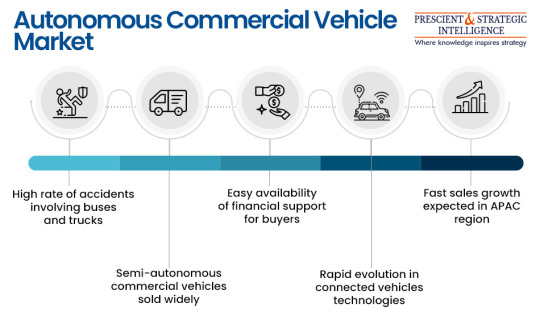
In recent years, the semi-autonomous category, on the basis of vehicle autonomy, contributed a higher revenue share. Vehicles must be fortified with electronic stability control or at least one of the progressive driver-assistance system ADAS features (either for steering or acceleration) to attain level 1 automation. Most of the European nations and the U.S. have forced the acceptance of basic ADAS features in all new commercial vehicles, which essentially makes all of them semi-autonomous.
In recent years, the truck category held the larger market share, and the category is projected to remain dominant in the vehicle type segment of the industry during the projection period. This can be credited to the growing utilization of autonomous trucks for logistical processes, like domestic logistics transportation, automated material handling, logistics digitalization, and yard management.
In the coming few years, on the basis of the application segment, the public transportation category is projected to advance at the fastest rate. This can be credited to the rising acceptance of autonomous shuttle facilities for public mobility reasons. Numerous start-ups and recognized businesses are coming up with strategies to grow level 5 autonomous shuttles for public transport. Such shuttles will not need human drivers for the process, which will aid transportation agencies save on working prices.
In the past few years, the North American region dominated the industry with the highest revenue for the autonomous commercial vehicle market, and the region is also projected to remain in the top spot during the projection period. This can be mainly credited to the increasing research and development activities on autonomous automobiles and growing aid from the federal and state governments for advancing autonomous driving technologies.
The APAC region is projected to witness the fastest development because of the booming vehicle industry here. APAC is the globe's largest vehicle maker, responsible for almost half of the annual production.
Hence, the continuing development in commercial vehicle technologies, growing government aid for autonomous commercial cars, and rising requirement for effective advantages are the major factors propelling the market.
#Autonomous Commercial Vehicles#Self-Driving Trucks#Logistics Automation#Transportation Industry#Freight Efficiency#Connectivity Solutions#Driverless Technology#Market Trends#Fleet Management#Autonomous Delivery#Truck Platooning#Market Players#Freight Transportation#Urban Mobility#Automation Innovation#Autonomous Trucking#Safety Systems#AI-driven Logistics#Long-Haul Trucking#Commercial Vehicle Automation
0 notes
Text
Decoding KSA's Warehousing Automation: Demand and Supply Insights: Ken Research
Saudi Arabia (KSA) drives warehousing automation as a regional logistics epicenter, fueled by a consolidated market and booming e-commerce demand.
Storyline
Saudi Arabia's infrastructure initiatives drive demand for automated warehouses.
Growing demand for cold storage services presents growth opportunities.
Focus on e-commerce and retail fuels demand for automation.
As per Ken Research estimates, Warehousing and logistics industry poised to undergo a transformative automation phase.
Existence of a consolidated market scenario amongst the growing warehousing automation industry globally, KSA’s government has made the push to turn the nation into a Regional Logistics Epicenter necessitating automation as the key parameter for a Regional Logistics Chain, enabling faster growth of KSA’s warehouse automation industry. On the other hand, an unprecedented surge in E-commerce market has balanced the demand side of the market. In this piece, we uncover the industry landscape, demand & supply side of KSA’s Warehousing automation industry.
1.Supply side boost: Government Plans and E-commerce Fuel Automated Warehouses in KSA.
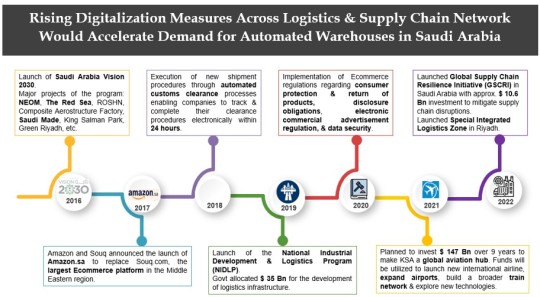
To learn more about this report Download A Free Sample Report
Saudi Arabia's ambitious government infrastructure plans, including initiatives like NEOM, The Red Sea, ROSHN, and the National Industrial Development & Logistics Program (NIDLP), have created a solid foundation for the logistics network in the country. These developments, supported by a $35 Bn allocation for logistics infrastructure, have led to an increased demand for automated warehouses. (~$ 100 Bn in its transportation & logistics infrastructure) The focus on efficiency, speed, and accuracy in the supply chain has made the implementation of automated warehouse solutions essential. This growing demand is driven by the booming e-commerce industry's evolving requirements, the need to streamline operations, and ensure timely deliveries.
2.Demand Surge: Saudi Arabia's Rise as a Transshipment Hub Spurs Demand for Affordable Modern Warehouse Solutions.
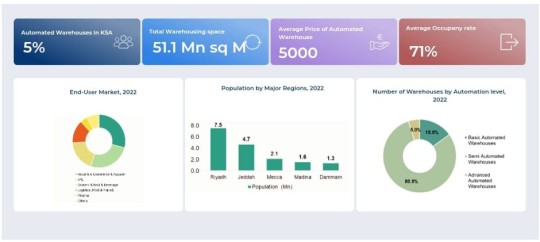
Visit This Link: - Request For Custom Report
The rising demand for cold storage services in Saudi Arabia, primarily driven by the food and beverage (F&B) and pharmaceutical sectors, is leading to significant growth opportunities. To cater to this demand, companies are adopting asset-light models and relying on third-party logistics (3PL) providers who offer specialized cold storage solutions, given that only 5% of the warehouses are currently automated. These providers leverage innovative technologies to ensure efficient operations and maintain the quality and integrity of stored products. As a result, companies are strategically expanding their warehouses and investing in cutting-edge solutions. This transformative phase is focused on meeting the evolving needs of the F&B and pharmaceutical sectors while gaining a larger market share.
3.“A balance to be the solution:” The demand and market share of e-commerce and retail is expected to increase in the future due to increasing focus towards reducing the overall sales cycle duration.
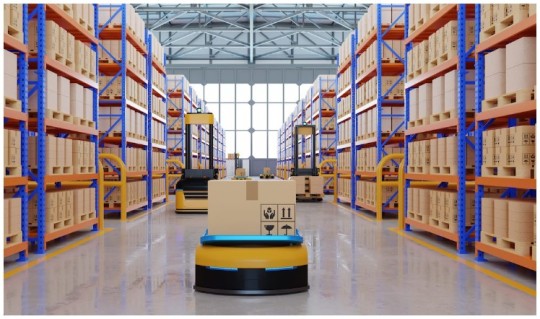
Request For 30 Minutes Analyst Call
Experience the transformative power of automation as it reshapes the warehousing and logistics landscape, propelling the retail and e-commerce industry into a new era. In this fast-paced world, e-commerce automation software becomes the key driver, enabling businesses to focus on their core strengths and strategic goals. The adoption of automated warehouse management systems empowers 3PL companies to achieve unprecedented efficiency, accuracy, and real-time inventory visibility, while reducing costs and enhancing customer service. As per our estimates at Ken Research, the market will grow at a steady pace undergoing transformative warehouse automation process.
#KSA Warehouse Automation Market#KSA Supply Chain Automation Market#KSA Inventory Automation Market#Trends KSA Warehouse Automation Market#KSA Warehouse Automation Market Opportunities#Challenges KSA Warehouse Automation Market#Number of Warehouses in KSA#Number of Logistics Service Providers in KSA#Competition KSA Warehouse Automation Markets#Schaffer Warehouse Automation KSA Market Share#Oracle KSA Market Share#Swisslog KSA Market Revenue#CIN7 KSA Annual Revenue#Grey Orange KSA Market Share#Ancra KSA Market Revenue#Fizyr KSA Market Share#Caja KSA Annual growth#Investment KSA Warehouse Automation Market#Leading Companies KSA Warehouse Automation Market#Emerging Companies KSA Warehouse Automation Market#Major Players KSA Warehouse Automation Market#KSA AMR Market#Handplus Robotics KSA Market Share#Fetchr KSA Market Revenue#Flytbase KSA Market#Warehouse Automations Lab KSA Market#Saco KSA Market Share#Actiw KSA Market Revenue#Airmap KSA Market Share#Welcome Bank KSA Market Share
0 notes
Text
UAE Logistics Market to grow at the rate of 7.5% in the upcoming period between 2021-2026 owing to government initiatives such as Expansion of sea ports alongside technological innovations such as Real-Time Tracking : Ken Research
History of steady growth alongside a positive future forecast provides UAE’s logistics Market increasing confidence & interest of stakeholders, says a report by Ken Research
1. Expansion of existing sea ports, emergence of e-commerce sector coupled with rising maritime, air cargo & land transport sector serves as major catalyst for the growth and development of logistics industry in UAE.
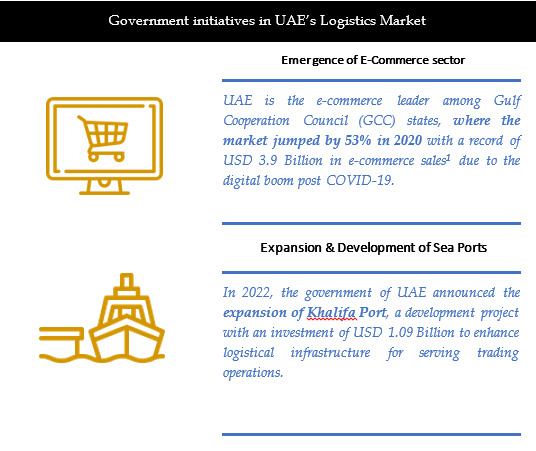
The government of UAE is aiming to establish it as a Logistics Hub by huge investments in the infrastructure. Initiatives such as development of sea ports (USD 1.09 Billion to enhance logistical infrastructure for serving trading operations) alongside a growing pharmaceutical & maritime industry will help UAE government to achieve the economic growth targets by 2040. The country’s strength lies mainly in its maritime sector. As per relevant data, the Bunker Supply Index ranked UAE 3rd globally in transport services and 5th globally as a key competitive maritime hub. As of 2022, there were more than 10 million cubic meters of crude and oil products storage capacity at Fujairah, making Fujairah the world’s No. 3 bunkering hub, which contributes in strengthening UAE’s position as a reliable supplier of crude oil. All in all, the country has a huge potential when it comes to expansion of its logistics sector.
Visit this Link:- Request for custom report
2. “Integrating Technology to market’s growth prospects:” With the increasing technological innovations and advancements across the world, logistics sector in UAE is also getting benefitted.
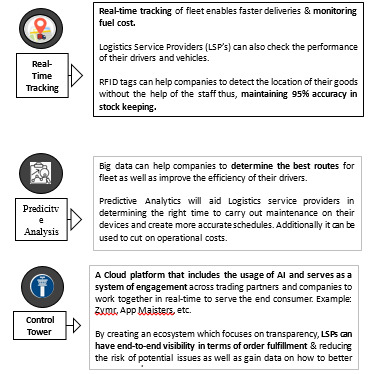
#Bollore Logistics UAE Annual Revenue#BSD City UAE Market Share#Ceva Logistics UAE Market Revenue#Challenges UAE Logistics Market#Competitors in UAE Logistics Market#Emerging players in UAE Logistics Market#Hellman UAE Market Share#Investment UAE Logistics Market#Leading Players in UAE Freight Forwarding Market#Leading players in UAE Logistics Market#Leading Sensors & Controls Providers UAE#Leading Warehouse Automation Service Providers#LinFox UAE Market Share#Major Identification & Data Capture Service Providers#Major Players in UAE Logistics Market#Mohebi Logistics UAE Market Share#NTDE UAE Market Revenue#Number of Cargo Trucks in UAE#Number of Trucks in UAE#Number of Warehousing Units in UAE#Opportunities UAE Freight Forwarding Market#Rhenus Logistics UAE Market Growth#Toll UAE Market Share#Top Material handling solution providers#Top Players in UAE Logistics Market#UAE Air Freight Market Revenue#UAE Automobile Freight Market#UAE CEP Market#UAE Freight Forwarding Market#UAE Industrial Warehouses Market Share
0 notes
Text
Last Mile LEVs in KSA to hold an attractive Future Potential with lucrative government initiatives.
Domestic express courier dominates the market and is expected to register revenue growth at a CAGR of 4.4%. Most e-commerce retailers in KSA struggle with last-mile delivery as delays, reduced success rate & difficulty cash on delivery (COD) handling. Inconsistent demand, with spikes during festive seasons such as Ramadan, put additional pressure on the supply-side ecosystem for e-commerce logistics and hyperlocal logistic service providers. E-com Retailers need to come up with solutions such as Tech-Enabled E-com Logistics Platforms/Automated Shipping Software, B2B SAAS Platforms, and Digital Freight Brokers/ Load Discovery Aggregator Platform to solve the LMD problem in an efficient way to meet the growing customer demands.

Other Challenges in Future Potential Market Of LEVs in Last Mile Delivery Industry in KSA.
Cities such as NEOM and SPARK are incorporating smart mobility into their urban planning.

Some cities in the GCC are already incorporating smart mobility into their urban planning. Saudi Arabia and the UAE will invest nearly $50 bn in smart city projects through 2025 and most of the smart city projects in the GCC have a distinct focus on mobility for residents. SPARK will be a fully integrated city with master plans to seamlessly intertwine industrial areas, such as factories, workshops, yards, and the Logistics Zone, with vibrant residential, educational, and commercial areas. Moreover, NEOM City consists of a city of a million residents with a length of 170 kilometers (105 miles) that preserves 95% of nature with zero car emission, zero streets and zero carbon emissions. Moreover, ABB, a global automation giant and a leader in electric vehicle (EV) infrastructure sector has supplied its market-leading EV chargers to a premier residential compound ‘Safa 28’ located in Riyadh, Saudi Arabia. All these government initiatives, makes a greater space of the EV sector to flourish which will help the Last mile LEVs sector to grow.
New types of vehicles and new logistic structures are emerging to address the new paradigm in E-Commerce Industry.

Download Sample Report
The rising competition to deliver faster has led to ecommerce and hyperlocal delivery players to partner with mobility players to expand their fleet while still staying lean on resources. E-commerce players like Noon and Amazon witnessing a large volume of orders and requiring larger delivery fleets will slowly move towards LEVs by partnering with e-mobility startups and suppliers to convert their fleet into an e-fleet. The lower total cost of ownership and operating costs have made EVs more attractive for the intra-city cargo segment which comprise ~40% of total E-commerce shipments in KSA. However, LEVs need to be as efficient as an ICE vehicles carrying a similar payload and covering more trips and at lesser costs. This has led to the growth of new types of vehicles and new logistic structures that are emerging to address the new paradigm in E-Commerce Industry.
Government policies play a huge role in Adoption of Electric Vehicles in a country.
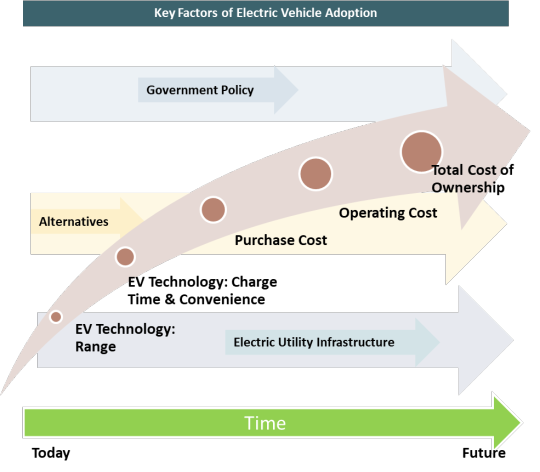
Ask for Customization
In November 2019, the Kingdom announced that 5% of its parking spaces are to be designated solely for the use of EVs. Also, and even more importantly, the Saudi government has mandated that there will be EV charging stations at all municipal car parks. National Industrial Development & Logistics Program (NIDLP) considered by CEDA to be one of the highly critical VRPs, will most likely develop initiatives geared towards EVs in the coming years. Furthermore, it focuses on developing ICE along with EV as it allows KSA to optimize short term gains while making calculated bets on EV over the medium term. Developing this sector will create jobs while contributing to the GDP.
High penetration acceptance of the use EVs could radically reduce the high rate for demand of oil.
Fossil CO2 emissions in Saudi Arabia are 526.8 million tones of CO2 in 2019. An EV has zero exhaust emissions. They are 100% eco-friendly as they run on electrically powered engines. The desire to reduce their carbon footprint is a motivator for environmentally conscious consumers to buy EVs. The cost of purchasing an EV is more than ICE. However, the operational costs requiring fuel and maintenance in ICE vehicle is more than that of an EV. The mass production of batteries and available tax incentives will further bring down the cost, thus, making it much more cost-effective.
Key Segments Covered in KSA LEV Market
Business Side Potential for LEVs in KSA CEP Industry
CEP Market Size
Total Number of Courier Shipments
KSA E-Commerce Landscape
E-Commerce Market Major Categories
Total Number of E-Commerce Orders
Total Number of Vehicles Deployed
Competition Scenario in KSA CEP Market
Future Projections Towards Penetration of LEVs in Courier Segment
Business Side Potential for LEVs in KSA Grocery Delivery Market
KSA Online Grocery Ecosystem
KSA Online Grocery Market Size
KSA Online Grocery Market Concentration
KSA Online Grocery Market Segmentations
Total Number of Orders
Total Number of Vehicles Deployed
Competition Scenario in KSA Grocery Delivery Market
Future Projections Towards Penetration of LEVs in Grocery Delivery Segment
Business Side Potential for LEVs in KSA Food Delivery Market
Landscape of Food Delivery Companies in Saudi Arabia
KSA Online Food Delivery Market Size
Total Number of Orders
Total Number of Vehicles Deployed
Competition Scenario in KSA Food Delivery Market
Future Projections Towards Penetration of LEVs in Food Delivery Segment
Key Target Audience
LEV Manufacturers
LEV Dealers/Distributors
Courier and Parcel Companies
E-Commerce Companies
Grocery Delivery Companies
Food Delivery Companies
Time Period Captured in the Report:
Historical Period: 2015-2020
Forecast Period: 2020–2030
Key Topics Covered in the Report
Overview of Global EV Market
Genesis and Overview of KSA LEV Market
Ecosystem of Major Entities in Saudi Arabia LEV market
Charging Infrastructure for LEV Market in Saudi Arabia
Overview of KSA Last-Mile Delivery Market
Number of Orders/Shipments in KSA Last-Mile Delivery Market
Number of Fleets Deployed for Last Mile Delivery
Business Side Potential for LEVs in KSA CEP Industry including E-commerce Landscape in KSA
Business Side Potential for LEVs in KSA Grocery Delivery Market
Business Side Potential for LEVs in KSA Food Delivery Market
Regulatory Scenario and Framework in Saudi Arabia LEV Market
Opinions of Industry Experts regarding adoption of LEVs
Difference in EV costs compared to ICE vehicles- Cost Benefit Analysis
Viable Supply Chain Model for Adoption and Supplying LEVs in KSA
Current Landscape of LEV Offering in KSA
Major Deals/Transactions for LEVs in KSA
Impact of COVID 19 on EV sales
Future Analysis and Projections for LEVs in Saudi Arabia
Opportunity Analysis of an LEV in Last Mile Delivery
Case Studies for LEV Last-Mile Delivery
Recommendations / Success Factors
Research Methodology
Appendix
Companies Covered:
EV Manufacturers
Tesla
BMW
Chevrolet
Renault
Hyundai
Nissan
CEP Industry
Saudi Post
Naquel Express
SMSA Express
DHL
Aramex
UPS
FedEx/TNT
Grocery Delivery Companies
Nana Direct
Zadfresh
Danube
Carrefour
Qareeb
Food Delivery Companies
Hungerstation
Careem
Jahez
Talabat
Mrsool
Contact us:
Ankur Gupta, Head of Marketing and Communications
+91-9015378249
#KSA Last mile Delivery LEV Market#Saudi Arabia LEV Industry#KSA Light Electric Vehicle Sector Outlook#KSA Electric Vehicle Market#Saudi Arabia E-Commerce Logistics Market#KSA CEP market#Saudi Arabia Battery Electric Vehicle sector outlook#KSA Plugged in Hybrid Electric Vehicle manufacturers#KSA Light Automated vehicle industry#KSA battery driven car industry outlook#Number of Battery Electric Vehicle Manufacturers KSA#Types of Electric vehicles KSA#Number of end users of LEV KSA#Number of e-commerce companies#CEP Industry KSA#KSA Grocery Delivery Companies
0 notes